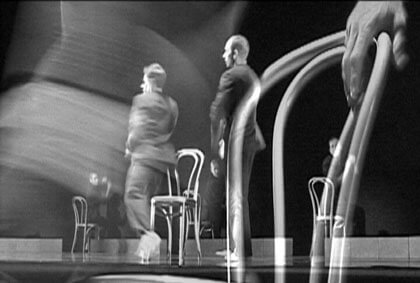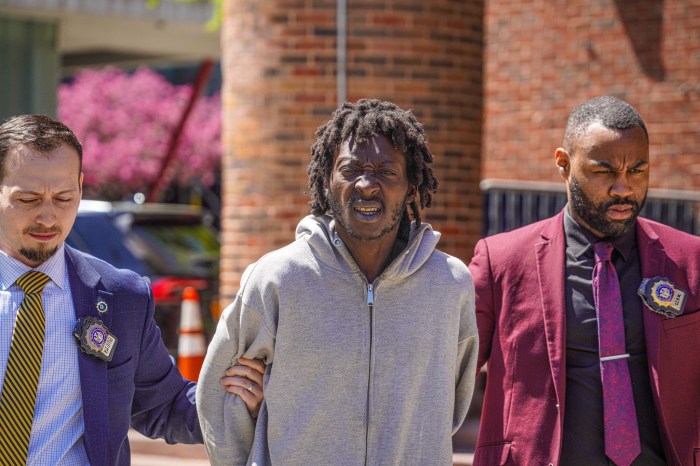California’s McCaleb Dance provides the innovation Altogether Different should deliver
By GUS SOLOMONS JR.
New York concert dance fans are always bemoaning the lack of good, serious concert dance on the “left coast.”
Lament no more! McCaleb Dance swept into Dance Theater Workshop June 16 through 19 from La Jolla, California, with a pair of smart dances that not only showed off the choreographic finesse of artistic director Nancy McCaleb, but also the kinetic and expressive skills of Ali Fischer, Eric Geiger, Sarah Kaye, Troy Sellers, and Elizabeth Swallow, her terrific dancers and creative partners.
In front of five piles of cinder-blocks, each in a different configuration—the setting was by Geiger—Sellers and the women, all dressed in dark men’s dress suits, posed sedately. Geiger strolled onstage to join them and sat. Blackout. In an ensuing series of short tableaus, the dancers hurled themselves repeatedly from their bentwood café chairs to the ground, as a dull roar momentarily obscured Christophe Zurfluh’s atmospheric sound score—the rumble of an earthquake.
A conceptual collaboration with noted artist Francis Alÿs, the dance, titled “The Impersonation of Mr. Peacock,” took us on “a journey without the illusion of a final destination.” McCaleb spooled out a seamless stream of incidents, inspired by Alÿs’ paintings. With Eloisa Haudenschild’s expertly edited video creating a background and Pamela Sherman’s imaginative lighting plot shifting us between indoor and outdoor spaces, the dancers hauled their chairs into new figurations, mumbled to imaginary listeners, hoisted legs skyward, and chucked their seats toward the wings.
As the video unfurled a panorama of rhythmic architectural facades: balconies, and windows, and digitally distorted images of the dancing, the live performers jumped, twisted, and fell in canons that morphed into trios and duets. Relationships flitted by without resolution but always with smoothly intelligent physicality. Momentum built, as dancers leaned and collapsed to the ground again and again. Never linear or explicit, “Impersonation” craftily maintained a balance between drama and mystery.
While “Impersonation” allowed the dancers to show only in brief flashes their formidable technical skills in service to the expressive idea, the other dance, “Verdigris,” let those talents reign. Their bikini swimsuits revealed strong, healthy physiques. Geiger’s muscles are etched like a Greek god; but all of them radiate energy and power that belies the stereotype of dancers as gaunt, underfed kinetic machines. These are the robust, beautiful bodies you’d expect to see on a San Diego beach, playing volleyball or surfing the waves.
The 20-minute exposition of pure, luscious, lyric movement, set to melodic computer music by Zurfluh and Michael Rodach, was backed by a stream of video images that recalled the hallucinations 19th-century painters experienced, using the eponymous toxic pigment. A narrow video band crept from right to left, then widened to fill the rear wall with extreme close-up views of nature, panning slowly to give the illusion of motion to the stage itself.
The dancers moved in full-bodied, breathy unison with sweeping extensions, and rolling falls. Then, a short interlude for Sellers and Kaye evolved into exuberant partnering: women shot through space like arrows in the arms of the men. Geiger jumped into Kaye’s arms; then, he in turn swept her up. McCaleb’s skillfully crafted, thoughtful, collaborative work epitomizes the kind of altogether special dance we’d like to see more of in the Altogether Different Festival at the Joyce Theater.
Let’s hope McCaleb Dance makes a return visit soon.


































